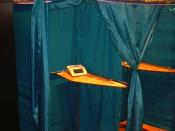Assumptions
Central voting server and counter server have a physically secured tamper-proof hardware. So, a potential hacker has no way of physically destroying or altering the hardware of the server.
Terminal is tamper-proof in the sense that there is no way to open up the terminal or modify its innards without irrevocably breaking the terminal.
Each terminal has an accurate, tamper-proof clock inside it. This is to allow the voting during the specified time-period
Each voter has been provided with an ID (which is a string of 256 bits printed on a laminated card with the voter's photograph and signature) which use to verify themselves during voting
Camera at top of terminal is tamper-proof to make sure it always in good condition
The cryptographic systems used are hard to break to make sure hackers can't do any bad things to the voting process.
Voter, central voting server and counter server do not collude with each other to make sure they didn't transfer their information secretly
Threats
It is possible that hackers hack the computer system of central voting server, counter server or terminal to cause the process of voting forced to suspend until system administrator recover the system.
Besides, it is also possible that someone send virus to the program. So, security is very important here to make sure voting process work as normal.
Attacker can send a lot of request to the central voting server and counter server. This will make the communication channel congested and the voting process will run very slow and cause many voters can't finish their vote by deadline.
It is possible that interception will occur. Attackers will get the IP addresses of terminals and hack the system of terminals. This will cause technicians keep going to different terminals and recover the system. This again...


